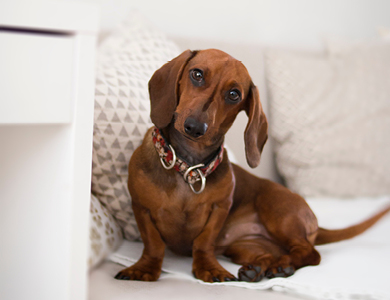Born to be independent hunters of dangerous prey, dachshunds can be courageous to the point of being imprudent and even a bit stubborn. However, their charming nature and unique appearance have won the hearts of millions around the world, including Queen Victoria and painter Pablo Picasso.
Physical appearance
The dachshund is a compact dog, with a long trunk, short legs and a muscular build. It carries its head high, proudly and with confidence, and has an intelligent facial expression.
There are two recognized sizes: standard, weighing more than 5 kg (11 lb), and miniature, weighing less than 5 kg, ideally less than 4.54 kg (10 lb). They often have short legs relative to their body. However, they should not appear to be handicapped, awkward or limited in their movements. In short, a dachshund should not be too slender to avoid resembling a weasel.
Dachshunds have three types of coats: smooth (short, thick and shiny), wirehaired (rough with a good undercoat) and longhaired, like that of an Irish setter. They come in a wide range of colours: black, black and tan, brindle, red, cream, chocolate, fawn, a combination of two colours and one of these colours with white spots. These colour combinations are referred to as dapple (merle). Dappling is generally not desirable and can be a sign of genetic abnormalities.

Life expectancy and health
The dachshund’s average life expectancy is 12 or 13 years, given an appropriate level of activity and diet. Some live up to 15 or 16 years. While it is generally a healthy breed, the dachshund does have certain specific health issues, including degenerative discopathy, partly the result of an extremely long spinal column and a short thoracic cage. In addition, a large percentage of dachshunds develop back problems. When buying a dachshund, dog owners should be prepared to deal with back problems, which can range from simple lumbar sprains to complete paralysis of the hind legs requiring major surgery. Other health issues affecting dachshunds include mainly obesity and various skin conditions.

Energy level and temperament
Dachshunds are smart and playful. However, like most hunting dogs, they can be quite stubborn, making them difficult to train. They’re known for their propensity to chase small mammals, birds and tennis balls with tremendous determination and fierceness. Dachshunds can be difficult to house train. Owners have to be patient and consistent during this training period. Many dachshunds don’t take kindly to strangers, and some tend to growl or bark when they meet someone they don’t know.
The behaviour of this breed doesn’t suit everyone. An untrained and bored dachshund can become destructive. If they’re improperly trained and not socialized at a young age, dachshunds can become aggressive and fearful. They need caring and attentive owners who understand their need for amusement and exercise. Dachshunds are not necessarily the best pets for young children. However, if they’re well socialized with young children who respect them, they will generally get along. In some cases, dachshunds can be aggressive and bite an unknown child, especially if the child moves quickly around the dog and teases it. Despite that, they’re very tolerant and loyal toward the children in their own family. Children should, however, be aware of the fragility of the dachshund’s back.
Maintenance and grooming
Dachshunds are considered moderate shedders. They’re relatively clean and have little body odour. The breed’s grooming needs vary depending on the type of coat. Dachshunds with a smooth coat are essentially “ready-to-wear” and require only a quick brushing or a once-over with a rubber grooming glove to look good. Longhaired dachshunds may need more frequent brushing, depending on the thickness of their coat. Wirehaired dachshunds can be clipped a few times a year for optimal results. Nails should be trimmed and ears cleaned on a regular basis.

Origins
The breed’s history dates back nearly 600 years in Germany. At the time, dachshunds were used for hunting foxes, rabbits and badgers, which they flushed out of their burrows. The dogs’ long bodies and short legs were expressly designed for this underground work. The name is derived from the word dachselhund—badger dog in German. The English name dachshund is closer to the original German, while Germans currently use the name dackel, which is closer to the French teckel. Some sources claim that the breed is even older, with its origins going back to Egypt, where depictions of identical dogs have been observed on Egyptian frescoes. The only difference is that the dogs’ ears were straight instead of drooping.
For more information, contact a registered breeder at the Canadian Kennel Club, who can answer all your questions. You can also contact the organization for information on breeders and the various breed clubs in Quebec and elsewhere in Canada.





